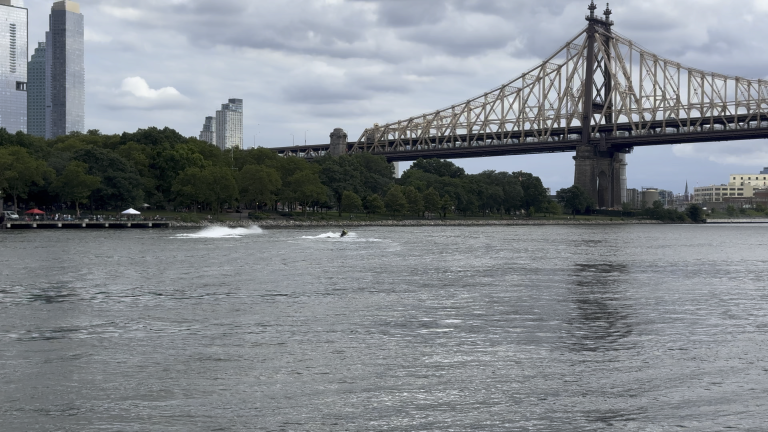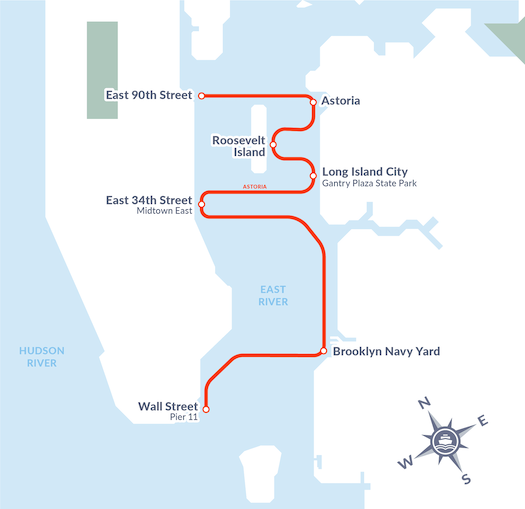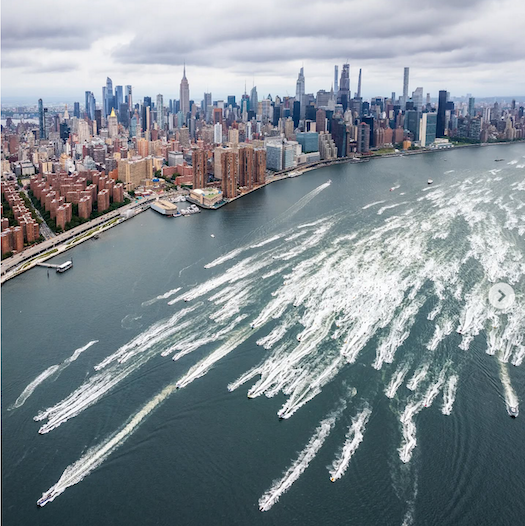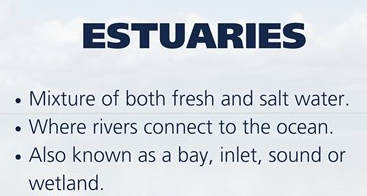
New York’s waterways see surge in recreational jet ski activity as tourism operators expand offerings
New York, N.Y. – The roar of engines echoes across the East River as personal watercraft streak past Manhattan’s iconic skyline, transforming New York City’s historic waterway into an unlikely aquatic playground.
What was once primarily the domain of commercial vessels and tugboats now hosts dozens of jet skis daily, carrying tourists and thrill-seekers on high-speed tours past landmarks from the Brooklyn Bridge to the Statue of Liberty.
The jet ski phenomenon represents a dramatic shift in how New Yorkers and visitors experience the city’s waterways. Hundreds of jet skis will ride down the East River to the tip of Manhattan, passing lady liberty and up the Hudson river along side the World Trade Center and lower Manhattan during organized events like the annual NYC Jet Ski Invasion, demonstrating the scale of this emerging recreational activity.

Safety Requirements Shape Urban Watercraft Operation
New York State and most other states don’t require a license to operate a personal recreational boat.

Instead, require boat operators to acquire a boating safety certificate according to current New York State regulations. However, personal watercraft operators face stricter requirements than traditional boat users.
As of January 1, 2005, you must have a boating safety certificate and be at least 14 years of age or older to operate a personal watercraft, creating clear age restrictions for jet ski operation.
The certification process involves completing a Boating Safety Education Course and passing written examinations covering applicable maritime regulations.
The U.S. Coast Guard classification of jet skis as personal watercraft subjects them to specific safety protocols.
Always make sure you are wearing a serviceable life jacket and Always utilize the kill switch attached from the switch by a lanyard to your life jacket whenever you are riding the PWC, safety experts recommend.
These requirements become particularly crucial in New York Harbor‘s congested waters, where commercial shipping, ferry traffic, and recreational vessels converge.
Rental Industry Transforms Accessibility and Economics
The rental market has revolutionized jet ski accessibility in New York City.

A new jet ski can be quite expensive, and they range anywhere from $5,000 to $20,000, making ownership impractical for most Manhattan residents.
Starting at $179 for hour-long tours, rental operations have made the experience accessible to tourists and locals alike.
Rental companies typically operate from locations in Jersey City, the Rockaways, and other outer areas where waterfront access and storage facilities are more affordable than Manhattan real estate.
These businesses provide guided tours rather than independent rentals, ensuring safety oversight while maximizing the tourist experience.
The economic model relies heavily on group bookings and guided tours.
Operators find that jet skis will ride down the East River to the tip of Manhattan in organized formations, providing both safety in numbers and enhanced photographic opportunities for customers seeking social media-worthy experiences against the vibrant Manhattan’s skyline.
Geographic Challenges Define Operational Patterns
New York City‘s complex waterway system creates unique operational challenges for jet ski businesses.
The East River, despite its name, is actually a tidal strait — and estuary — connecting Long Island Sound to New York Harbor.

Its strong currents, varying depths, and heavy commercial traffic require experienced guidance for safe navigation.
Most rental operations concentrate in areas with easier water access and less congested maritime traffic.
Jersey City locations provide proximity to Manhattan while offering more practical launching facilities than the city’s limited waterfront access points.
The Hudson River corridor has become particularly popular for guided tours, offering spectacular views of the World Trade Center, Ellis Island, and downtown Manhattan.
The Brooklyn and Queens waterfronts also host jet ski operations, though the East River‘s narrower channels and bridge clearances create additional navigation considerations.
Professional guides must navigate around ferry routes, helicopter landing zones, and designated shipping channels while maintaining safe distances from piers and waterfront structures.
Tourism Integration Drives Market Growth
Jet ski tours have integrated seamlessly into New York City‘s tourism ecosystem. Operators market experiences that combine traditional sightseeing with adrenaline-fueled adventure, appealing to visitors seeking alternatives to conventional tour boats and helicopter rides. The unique perspective from water level provides dramatically different views of familiar landmarks.
Tour packages typically include safety briefings, equipment provision, and guided routes past major attractions. Professional guides use waterproof communication systems to provide historical commentary and navigation instructions while maintaining group cohesion in busy waterways. The experience appeals particularly to younger demographics and international visitors seeking distinctive New York experiences.
Social media marketing has proven particularly effective for jet ski operators, with customers frequently sharing dramatic photos and videos of their waterborne adventures. The visual appeal of Manhattan‘s skyline from water level, combined with the excitement of high-speed watercraft, creates highly shareable content that drives organic marketing growth.
Regulatory Compliance Ensures Safe Operations
New York State and federal regulations govern personal watercraft operations in metropolitan waters. Local municipalities and other areas may have different requirements for age thresholds, creating complex compliance requirements for operators working across multiple jurisdictions.
Environmental considerations also influence operations. There are pretty strong tides and currents in the East River, requiring operators to plan routes around tidal conditions and weather patterns. Water quality concerns, while not prohibitive for watercraft operation, influence safety protocols and equipment cleaning procedures.
Commercial operators must maintain proper insurance coverage, Coast Guard documentation, and local business licenses. The multi-jurisdictional nature of New York Harbor operations requires compliance with New York State, New Jersey, and federal maritime regulations, creating complex administrative requirements for business operators.
Personal Watercraft Transform East River Into Urban Playground (July 20, 2025)
Audio Summary (75 words)
Jet ski rentals and tours have exploded in popularity along New York City’s East River and Hudson River, with multiple operators offering guided experiences past iconic landmarks. Rental costs range from one hundred seventy-nine to four hundred dollars per hour, requiring operators to be at least fourteen years old with boating safety certification. Most operators base their businesses in Jersey City or outer boroughs, traveling in groups for safety through the city’s busy waterways while providing unique perspectives of Manhattan’s skyline.
#JetSkiNYC #EastRiver #NYCTours #HudsonRiver #WaterSports #Manhattan #PersonalWatercraft
TAGS: jet ski rentals, NYC waterways, East River tours, Hudson River recreation, personal watercraft,
New York tourism, maritime safety, water sports NYC, Manhattan skyline tours, urban adventure
